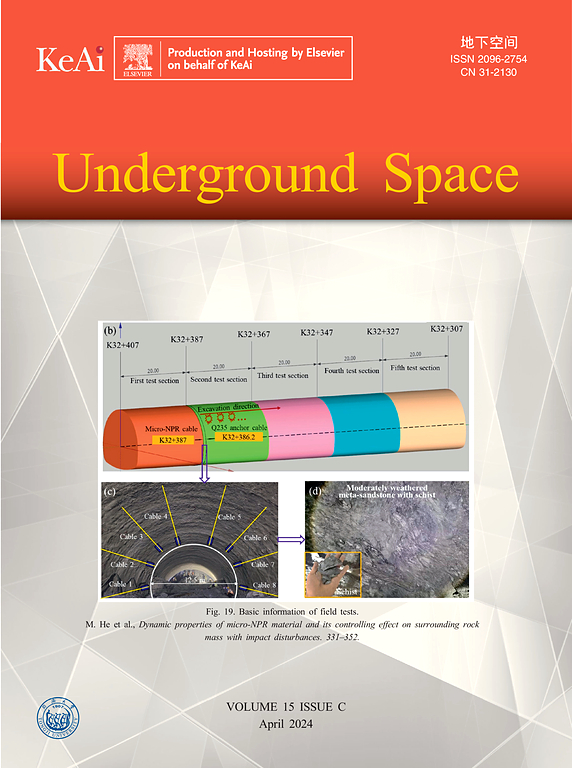Experimental investigation and limit analysis of shield tunnel face failure mechanism in sand
IF 8.3
1区 工程技术
Q1 ENGINEERING, CIVIL
引用次数: 0
Abstract
Shield tunneling in urban underground space necessitates tight control over support pressure at the tunnel face and a thorough insight into ground collapse mechanisms. This study conducts a model test and a theoretical validation to clarify the mechanisms of face failure and subsequent ground collapse in sand during earth pressure balanced shield (EPBS) tunneling operations. The experiment investigates the changes in soil pressure and surface subsidence patterns during shield tunneling and collapse stages, to elucidate the entire process of ground collapse triggered by shield tunneling disturbances. A novel methodology was proposed to ensure effective verification of the rotational failure mechanism, focusing on the collapse pit morphology and the critical collapse pressure. The results indicate that: (1) precise control over the shield tunneling and screw conveyor rotation speeds is essential for tunnel face stability; (2) the sand with low moisture content is prone to stepwise ground collapse under shield tunneling disturbances; (3) soil pressure measurements at the cutterhead are more indicative of face failure and imminent ground collapse than those from the soil chamber; (4) there is a consistent alignment between the rotational failure mechanism and observed collapse pit morphology, albeit with slight variations due to tunneling disturbances; (5) the experimentally determined critical collapse pressure is higher than the theoretical prediction, indicating an underestimation of risks in the current model. The study advances the understanding of the face failure mechanisms in shield tunnels, thereby providing insights into the design and safety of shield tunneling within engineering practices.
砂中盾构隧道工作面破坏机理试验研究及极限分析
在城市地下空间进行盾构隧道施工,需要严格控制巷道工作面支护压力,深入了解地表塌陷机理。本文通过模型试验和理论验证,阐明了平衡土压盾构(EPBS)隧道掘进过程中工作面破坏及后续塌方的机理。通过对盾构掘进和塌陷阶段土压力变化和地表沉降规律的研究,阐明盾构掘进扰动引发地面塌陷的全过程。提出了一种新的方法,以确保有效验证旋转破坏机制,重点关注塌陷坑形态和临界坍塌压力。结果表明:(1)精确控制盾构掘进速度和螺旋输送机转速对巷道工作面稳定至关重要;(2)含水率低的砂土在盾构扰动作用下易发生逐级塌陷;(3)刀盘处的土压力测量比土室处的土压力测量更能指示工作面破坏和即将发生的地面塌陷;(4)旋转破坏机制与观测到的塌陷坑形态之间存在一致的一致性,尽管由于掘进干扰而略有变化;(5)实验确定的临界坍塌压力高于理论预测,表明当前模型低估了风险。该研究促进了对盾构隧道工作面破坏机制的认识,从而为盾构隧道的设计和安全提供了工程实践的见解。
本文章由计算机程序翻译,如有差异,请以英文原文为准。
求助全文
约1分钟内获得全文
求助全文
来源期刊

Underground Space
ENGINEERING, CIVIL-
CiteScore
10.20
自引率
14.10%
发文量
71
审稿时长
63 days
期刊介绍:
Underground Space is an open access international journal without article processing charges (APC) committed to serving as a scientific forum for researchers and practitioners in the field of underground engineering. The journal welcomes manuscripts that deal with original theories, methods, technologies, and important applications throughout the life-cycle of underground projects, including planning, design, operation and maintenance, disaster prevention, and demolition. The journal is particularly interested in manuscripts related to the latest development of smart underground engineering from the perspectives of resilience, resources saving, environmental friendliness, humanity, and artificial intelligence. The manuscripts are expected to have significant innovation and potential impact in the field of underground engineering, and should have clear association with or application in underground projects.
 求助内容:
求助内容: 应助结果提醒方式:
应助结果提醒方式:


